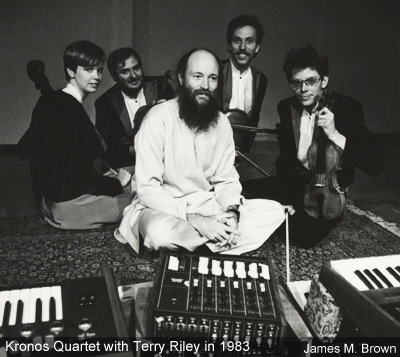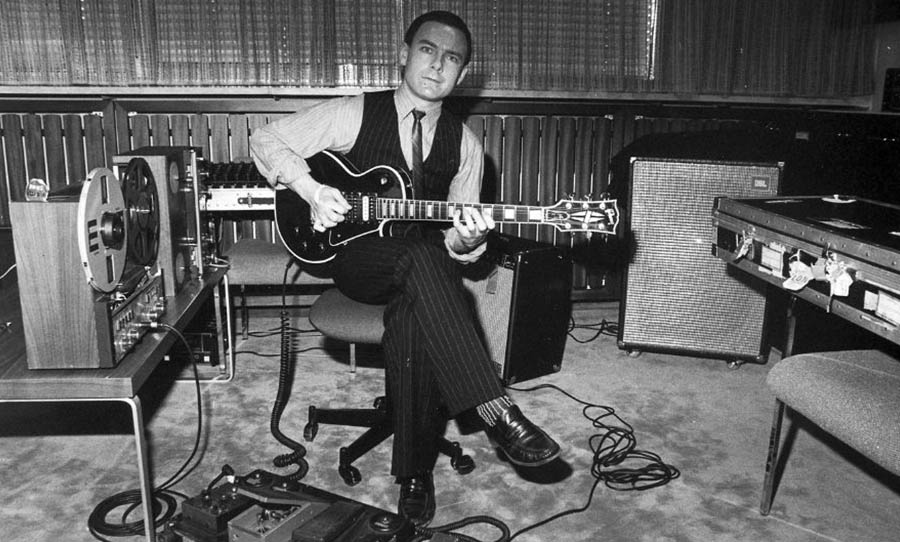
Picture of Terry Riley with the Loop Pedal in 1898 (Prasad, 2014).
The loop pedal technology has been recently made popular again through Ed Sheeran’s “Shape of you” performance in 2017, but this technology has had a long lineage before. It can be seen throughout different kinds of genres and musical settings in the past couple of decades. Traced back to 1953, the loop pedal was originally created by guitarist and instrument maker Les Paul and has become a widely used technology since then (Madden, 2019). Les Paul used a very simple loop pedal within his performances, as it was the first of its kind. His loop pedal allowed him to record one part of a song, play it back, and then accompany the song further through live singing and instrumentation (Renzo & Collin, 2017). This is still how the loop pedal is used today, but they have greatly advanced in technology since the 1950s.
One of the first major artists to use this technology was Terry Riley in his 1969 performance of “A Rainbow in Curved Air” (Madden, 2019). In Terry Riley’s performance, you can hear how Riley uses a melodic bass with layers of repetition. This performance was one of the first compositions that incorporated tape loops into a live performance. Riley’s engineer created long, repeated loops “by stringing the tape between two tape recorders and feeding the signal from the second machine back to the first to recycle along with the new incoming signals” (Renzo & Collin, 2017). This can be heard throughout the performance below.
Terry Riley- “A Rainbow in Curved Air” (Terry Riley 2014, 00:00-18:47).
The next artists to follow Terry Riley’s lead were King Crimson and Robert Fripp, who created “Frippertronics” through the loop pedal in 1979 (Madden, 2019). They used this technology to create a multi-layered guitar loop used during their live performances. This was widely popular, but the loop pedal technology was still a very new phenomenon at this time.

Robert Fripp with a Loop Pedal (Osborne, 2021).
The 1990s marked a time when music technology became increasingly popular and more affordable, which allowed more artists to buy and incorporate the loop pedal into their performances. As seen below, in 2006, KT Tunstall performed her song “Black Horse and the Cherry Tree” on Jay Leno. You can see how this technology is used to create a thicker texture and capture the audience’s attention. She incorporates a much more advanced style of loop pedaling compared to both Terry Riley and Robert Fripp, as the technology underwent improvements that allowed her to loop her voice, acoustic guitar, and tambourine. This performance displays how an artist can perform such advanced songs on their own without the help of other artists (Madden, 2019). This inspired many amateur artists to then look into and invest in the loop pedal technology, such as John Rockliffe (Madden, 2019). Rockliffe covered the Coldplay Song “Viva La Vida” in 2008 and was one of the first loop pedal cover recordings to gain popularity (Madden, 2019. Since then, there have been many more loop pedal covers of all different types of songs.
KT Tunstall on Jay Leno (Tunstall 2009, 00:00-03:52).
An example of the recent transformation of the loop pedal from being mainly associated with acoustic guitar to a more advanced musical setting is seen through artist Tune Yards in their 2011 performance of “Bizness” (Madden, 2019). This artist created their own “brand of frenetic multi-instrumentalism,” in which a thick texture is created through the riff of a saxophone, vocal runs, and percussion (Madden, 2019). This use of the technology can be heard below within the performance. The loop pedal allows Tune Yards to create the sound and quality of a band and orchestra while only having one person performing.
Tune Yards live performance of “Bizness” (Tune Yards 2011, 00:00-06:17).
This history of the loop pedal and the different ways in which the technology was used in order to advance a musician’s ability to perform shows the significance of the loop pedal. One of the next major artists to use the loop pedal was Ed Sheeran in his 2017 performance of “Shape of You.”